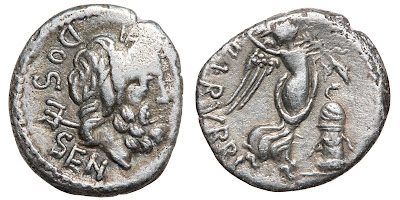 |
| A silver quinarius of L. Rubrius Dossenus |
One side shows Neptune, the sea god, and we know this because of the trident he has over his left shoulder. The other shows winged Victory, walking right in an ecstatic way, with her palm leaf over her left shoulder and a wreath in her flung-back right hand.
The object to her right is interesting. The authorities have labeled this sometimes as a snake coiled around an altar, and sometimes as a snake round a basket belonging to Aesculapius. These are both wrong, though the connection to Aesculapius is real enough.
To see what it really is, you need some background.
The Omphalos was a dome-shaped stone at Delphi, the navel of the world. This holy stone was draped with a mesh of raw wool, an agrenon. It was associated with the god Apollo, who was worshipped at Delphi. Apollo was sometimes a healer, and he passed this ability to his son Asklepios (known as Aesculapius to the Romans) who was a minor god of healing.
 |
| A bronze AE22 of Pergamon in Mysia |
There was a sanctuary of Asklepios at Pergamon, where snakes roamed the precincts. Snakes were a symbol of health and welfare. Visitors would sleep in the grounds overnight, and in the morning the priests would interpret their dreams; this was called incubation. This sanctuary was so important to the town that their coins referred to it directly, like this bronze coin; here is the Omphalos, covered with an agrenon and entwined by a snake, and the legend translates as "(Coin of) Asklepios the Saviour."
So, knowing this, you can see that the object on the first coin, sitting on top of a garlanded altar, is the same omphalos and snake symbol. It as been suggested that the appeal to Aesculapius relates to a plague, either in the year the coin was made (87 BCE) or in the time of one of the ancestors of the moneyer who had the coin struck. These are just conjectures, but there is no mystery about the nature of the object on the coin.
No comments:
Post a Comment